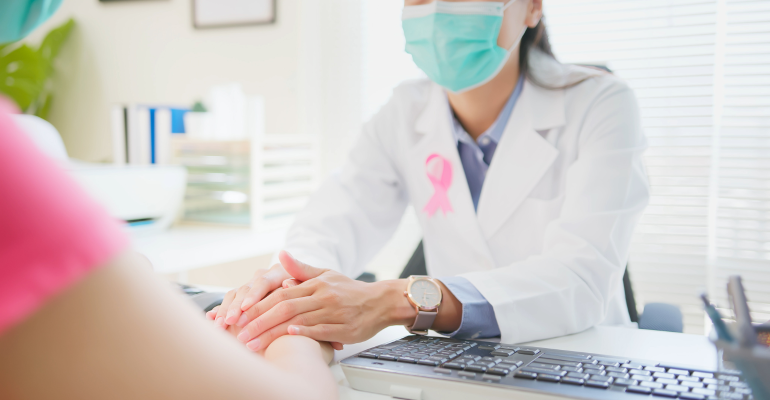Breast cancer is the most common form of cancer across the world and common risk factors for the disease include age, genetic mutations, personal and family history of breast and ovarian cancer, having dense breasts, being overweight or obese, and an unhealthy lifestyle that includes smoking and alcohol consumption. People who have had radiation therapy, or hormone replacement therapy, also face a heightened risk of developing breast cancer.
“While breast cancer is much more common in women, it can also affect men. The incidence of breast cancer in men is significantly lower compared to women, but it is not exclusive to one gender. Approximately 0.5 to one per cent of breast cancers occur in men,” Dr. Stephen Grobmyer, Institute Chair of the Oncology Institute at Cleveland Clinic Abu Dhabi.

Dr. Stephen Grobmyer, Institute Chair of the Oncology Institute at Cleveland Clinic Abu Dhabi
He added that breast cancer was among the top-ranked cancers among men and women in the UAE and the leading cause of cancer deaths in 2019, with an estimated average of 11.6 per cent of cancer deaths per year. The number of breast cancer cases among women is much higher compared to that in men.
“According to the 2019 Cancer Incidence in the Annual Report of the UAE, there were 875 breast cancer cases in women as opposed to eight cases in men. Creating awareness is one of the most important things that we can do to reduce the burden of breast cancer,” he said.
Related: Advances in aggressive breast cancer treatments
The well-known recommendation to begin screening for breast cancer at 40 years is based on statistical evidence showing that the risk increases with age, and that earlier detection often leads to better outcomes. However, some women may require more frequent screenings, especially if breast cancer runs in the family, or there is an inherited genetic mutation. It is also important to prioritise healthy lifestyles to reduce overall cancer risk.
Additionally, technology has greatly improved survival and recovery rates among patients. Dr. Bassel Jallad, Staff Physician at Cleveland Clinic Abu Dhabi, added: “Medical advances in recent years have resulted in the emergence of pioneering diagnostic and therapeutic techniques for breast cancer treatment and have contributed to the high rates of recovery from the disease. Those advances also mean that women who suffer from breast cancer now have a variety of options, depending on their condition.”

Dr. Bassel Jallad, Staff Physician at Cleveland Clinic Abu Dhabi
For therapeutic techniques, options include medication to treat breast cancer including hormonal therapy, chemotherapy, and targeted therapies. Other interventions include surgical treatment and radiation therapy, to reduce the risk of local cancer recurrence.
“We are also now using immunotherapy to treat breast cancer where the immune system is activated to eliminate breast cancer from the body. For patients who require surgery, our multidisciplinary teams often combine removal of the tumour with the reconstruction of the breast and lymphatic system to optimise recovery and limit side effects,” he added.
Lymphoedema, which is often triggered by breast cancer, axillary lymph node dissection surgery for cancer, or radiation treatment, is a debilitating condition that manifests as acute swelling of the upper arm after metastasised lymph nodes are removed. The condition brings an increased possibility of infection, along with social, mental and physical implications for those already undergoing cancer treatment. One in five patients is prone to developing breast cancer-related lymphoedema and this can be addressed either through lymphedema-preventive super-microsurgery or novel vascularised lymph node transfer.
Sharing insights into the case of a recent 51-year-old breast cancer patient suffering from lymphoedema who was treated using vascularised lymph node transfer treatment, Dr. Raffi Gurunian, Department Chair and Chief of Plastic Surgery at Cleveland Clinic Abu Dhabi, said: “The patient had had a mastectomy to remove her affected right breast, followed by radiation therapy. Her lymph nodes had also been removed to treat the breast cancer, and when she presented to us, she had swelling in the right arm.
Related: Busting the myth of male breast cancer
“During her subsequent breast reconstruction procedure, we transferred healthy lymph nodes from her groin area to the right armpit, while also using abdominal tissue to reconstruct her breast, using the DIEP (Deep Inferior Epigastric Perforator) flap technique, one of the specialised technologies available at the Fatima bint Mubarak Center,” he said.

Dr. Raffi Gurunian, Department Chair and Chief of Plastic Surgery at Cleveland Clinic Abu Dhabi
This is the first case in the UAE involving the usage of vascularised lymph node transfer with a DIEP flap breast reconstruction to treat lymphoedema. “To ensure its success, we made use of a new technology known as the Indocyanine Green machine (ICG machine). This ICG machine uses a florescent dye to detect the perfusion of the blood vessels, allowing us to harvest healthy tissue and lymph nodes for the reconstruction,” he added.
Cleveland Clinic Abu Dhabi’s Breast Health Clinic’s multidisciplinary cancer programme continues to raise awareness around breast health and cancer prevention alongside the importance of regular screening.
Get the latest insights from the healthcare industry straight to your inbox. Subscribe for a bi-weekly roundup of the latest healthcare tech, trends, innovation and patient experience, accompanied by exclusive interviews from the industry’s leaders.
___


